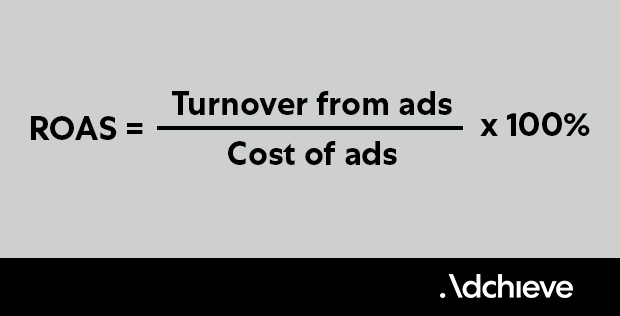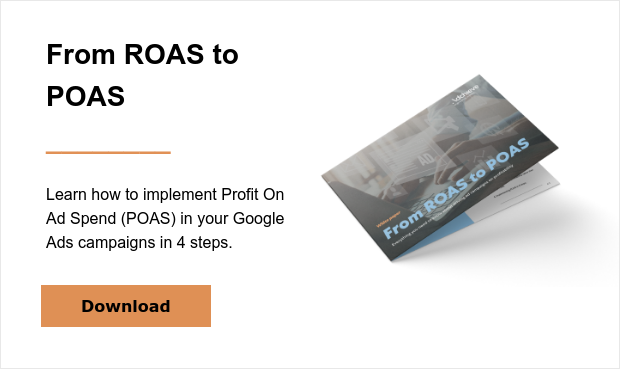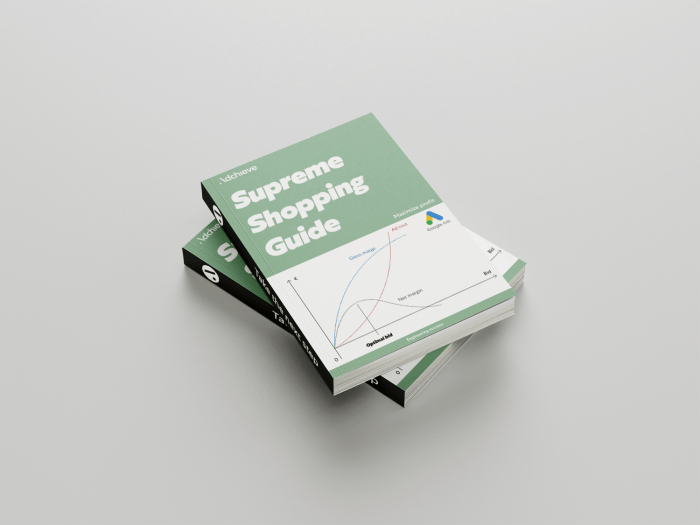Download tip: Download the guide: From ROAS to POAS and learn how to implement Profit On Ad Spend step-by-step in your campaigns.
ROAS meaning
ROAS means Return On Ad Spend. This important Google Ads KPI represents the ratio of the revenue you get from your ads (return) to the costs you make for the ads.
ROAS Formula: how to calculate Return On Ad Spend?
The formula to calculate your ROAS is quite simple:
ROAS = Turnover from your ads / Costs of your ads * 100%
Suppose you spend €500 on advertising costs in a month and the turnover you generate with these ads is €2,500, the calculation of your ROAS is:
€2.500 / €500 * 100% = 500%
If you are familiar with Google Ads, you will recognize that Google uses the quotation with percentages, as above. But in many cases, the 100% multiplication is omitted. So in this example, you would have a ROAS of 5.

Target ROAS
You can make a distinction between the ROAS you have achieved and the ROAS you want to achieve. The ROAS you have achieved can be calculated. The ROAS you want to achieve is also called target ROAS. If you manually set your own bids in your campaigns, you can try to work towards that target ROAS.
If you have your bids managed by an algorithm, you instruct the algorithm to reach the target ROAS. With Google Ads, you can set the target ROAS yourself for Search, Shopping and Performance Max campaigns.
What is a good Target ROAS?
The question then, of course, is what a good target ROAS is. In practice, rules of thumb are often applied, such as “my advertising costs could be 10% of my turnover”. This is often calculated in advance, taking into account other costs, how much profit you want to make per sale and what your advertising costs may be.
A good ROAS for one advertiser does not have to be a good ROAS for another advertiser. In addition to your costs that determine your margin, there are other aspects you can take into consideration:
- How do you calculate the profit, what do you include in your profit and what not?
- Would you like to gain a lot of market share in your sector, or would you like to focus on the profit you make from your campaigns? And where do you put the balance between the two?
- Is the margin for each product you sell the same, and can you achieve one ROAS target or do you perhaps need several targets?
- Do you have a different ROAS depending on the phase in the conversion funnel? For example, a different ROAS for brand-related and remarketing campaigns than for your non-branded campaigns?
How do you calculate the profit?
When you start calculating a ROAS, the costs are often quite obvious. Platforms like Google and Amazon report neatly. You know exactly what you are paying, and you can request the costs for any period you want.
Calculating your exact profit is more difficult. Advertising platforms such as Google are, of course, happy to report the highest possible turnover. The higher the turnover, the more you will spend on advertisements. But, have you also thought about the points below:
- In the turnover you measure within the advertising platform, the VAT is included, while the costs are charged without VAT. Are you taking this into account?
- The advertising platform calculates the ROAS on the sold turnover. Returns, for example, are not subtracted from the turnover later on, while returned products do not ultimately contribute to your yield.
- To what channel do you attribute a sale? This is especially the case with non-closed platforms such as Google and Facebook. Before someone actually proceeds with a purchase, he or she may have made several visits to your website via different channels. If you do not take this into account, Google Ads will by default allocate all sales entirely to itself, while other channels were also involved. As a result, you will often see different results in Google Ads than in Google Analytics. So think carefully about the attribution of your sales.
ROAS does not equal profit
A ROAS target does not mean that you will achieve your maximum profit.
The target ROAS you use or define, will lead to underlying bids within the advertising platform. A high target ROAS leads to lower bids and lower positions in the search results of Google and Amazon.
It is possible that if you set your target ROAS higher, your margin per sale may be lower, but your total sales volume will increase so that you will earn more in total. So, if you want to optimize your margin, it makes sense to experiment with different ROAS targets in order to see how you can achieve a maximum result.

There is not one ultimate ROAS
If you sell more than one product, the margin per product will often not match. Also, the target ROAS of these products will most likely be different. By deploying multiple campaigns with a different target ROAS, you can control product groups separately.
Certain events that influence the results can also prompt you to set a different objective. On Black Friday, for example, you may want to set a lower target ROAS. Or a higher target ROAS, because your margins will then be smaller.
Adjustments to the target ROAS can also help boost your sales. For example, if you find it difficult to get rid of a certain stock of products, it can help to lower your target ROAS, to sell the products faster.
As you can see, the ROAS formula in itself is quite simple. However, its effective use is highly dependent on many company-specific factors.
POAS vs. ROAS
Did you know that ROAS can be misleading and can even lead to wrong decisions? This is mainly because ROAS does not take margin into account. For this reason, the table above contains a margin assumption, we need this to calculate profitability.
However, you can truly optimize ad campaigns on profitability with POAS, which means: Profit On Ad Spend. You read all about this in our article: Why choose POAS target over ROAS?
Download tip: Download the guide: From ROAS to POAS and learn how to implement Profit On Ad Spend step-by-step in your campaigns.




